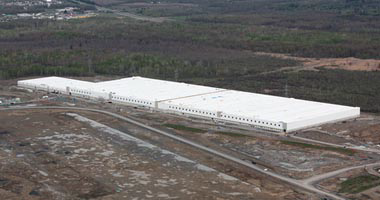|
Canadian Grocer Blog Entry: December 31, 2013 (here)
In 2012, I wrote a somewhat controversial article which explained why Cornwall, Ontario, a small Canadian city of 46,000 people, is gradually becoming a Canadian epi-center for supply chain operations (click here). At the time, I predicted that Cornwall would continue to attract distribution and manufacturing companies because of its strategic geographic location. This because Cornwall is in Ontario and it is just across the border from Quebec thereby providing cost-effective access to the Quebec market.
In December, 2013, Supply Chain Management (SCM) issued a press release to announce that they will be expanding their existing Cornwall distribution operation to include a High Velocity Distribution center (HVDC). The HVDC will service Walmart’s Eastern Canadian stores with ambient grocery (non chilled, non frozen) and high velocity / high cube products (paper towels, toilet paper, water, baby food, etc). The HVDC will be a business within a business and will exist within the current SCM building such that an overall increase in volume of 10% is projected (Ed. note - Walmart has since taken over the distribution center from SCM in 2014).
By way of information, SCM is a third party logistics company that Walmart has worked with since 1994 when the company first entered into Canada with its acquisition of 122 Woolco stores from Woolworth Canada. In the United States, Walmart does not outsource any of its 42 general merchandise distribution centers. When the company entered into the Canadian market, it was uncertain about the landscape and decided to outsource its distribution operations to a third party logistics service provider. At the time, they partnered with Tibbett & Britten Group Canada Inc. which eventually opened up a new company called Supply Chain Management to provide Walmart with dedicated retail logistics services. A general merchandise distribution center was constructed in Cornwall in 1999/2000 to service Eastern Ontario, Quebec, and the Maritimes all the way out to Newfoundland. Today the facility is 1.42 Million square feet and employs over 1,000 associates. To this day, it remains one of the largest distribution centers in Canada.
By locating its distribution center in Canada, Walmart unknowingly created a launch pad for the city to become a new Canadian epi-center for distribution and manufacturing companies. Over the past decade a number of high profile distribution centers have been built in the Cornwall Business center including:
- In 2010, Shoppers Drug Mart opened a new 550,000 square foot distribution center on a 64 acre property in Cornwall's main industrial park right beside the Supply Chain Management facility. The Shoppers Drug Mart facility employs approximately 130 full-time associates and is outsourced to a third party logistics
 provider (Matrix Logistics Services). provider (Matrix Logistics Services).
- In 2011, Target Canada started construction on a new 1.4 Million square foot distribution center which was opened in 2013. The facility is located on a 169 acre property in the Cornwall Business Park. The operation is outsourced to Eleven Points Logistics (EPL is a subsidiary of Genco) with 400 new jobs created at the time of start-up. The Target facility services about 41 stores in Eastern Ontario, Quebec, and the Maritimes including Newfoundland with the furthest stores being 1644 miles away from Cornwall.
- In December 2013, The Benson Group announced that they are expanding their 213,000 sq. ft. auto parts and tire distribution center in the Cornwall Business Park following the acquisition of a 217,000 sq. ft. building across the street from its Headquarters. This will result in a total footprint of 430,000 sq. ft. of building space on 60 acres.
- In 2012, Boundary Properties acquired 121 acres of land which is rumored to be the future home of a 600,000 square foot retail distribution center. Reliable sources indicate that it may be a grocery distribution center to be constructed for Loblaws but this is not confirmed.
- Other companies like Atelka and Olymel have been growing their operations and creating new jobs and high profile growth opportunities for the city of Cornwall.
Cornwall is 114 km (71 miles) away from the City of Montreal which has a population of 1.6 Million people and an estimated metropolitan area population of nearly 3.9 million people. Purely from a transportation perspective, it is more logical to position large distribution centers nearby Montreal for two reasons:
- To be closer to the Port of Montreal which means inbound import containers can be transferred into the distribution centers with a short haul trip.
- To reduce outbound transportation miles to points of demand in Montreal, and all locations east of Montreal. After all, every truck that departs from Cornwall to service stores in Montreal, in Quebec, and in the Maritimes, is effectively driving 228 km (142 miles) further return as compared to departing from Montreal.
So why then are companies establishing business operations in Cornwall? Based on my discussions with executives from companies that are making these decisions, the following reasons are cited:
- The land that is being offered for sale in the Cornwall Business Park is selling for about $20,000 per acre fully serviced which is very reasonable when one considers that land costs can reach $700,000+ per acre in urban centers such as Vancouver and Calgary. In general, start-up costs are also relatively low. Along the 401 Highway, this is an outright bargain relative to other locations.
- Less political bureaucracy – Quebec is the only province that has two separate taxation systems which significantly increases administrative expense and hassle factor.
- Higher fuel prices – Quebec consistently has gas prices between 5 to 10 cents higher per liter than neighboring Ontario which is purely because of imposed provincial taxes. This burden is a major disadvantage given that distributors have to run major trucking operations to move goods to market. For some companies, fuel expense can be in the tens of millions of dollars annually and this gas price difference can be a show stopper.
- Property and business taxes are generally lower in Cornwall than in Montreal. Companies are quite simply choosing to set up distribution and production facilities in Eastern Ontario because of lower operating expenses, despite the transportation penalty of being in Cornwall relative to being in Montreal.
- Quebec has a highly unionized labor force as compared to Ontario which has a large non-unionized labor force. Unionization rates in Canada vary by province and by industry. In general, the unionization rate in Canada has decreased gradually over time, falling from 33.7% in 1997 to 31.4% in 2009. In 2009, 39.8% of Quebec workers belonged to a union as compared to Ontario at 27.6%.
- Quebec has very strict language and labor laws that make it unattractive for big companies from the United States and the rest of Canada to set up distribution centers in the province. The business reality is that companies that are not "Quebec-based" simply do not wish to incur the additional overhead expense, human resource requirements, and hassle factor to adhere to Quebec's strict language and labor policies.
- In short, companies want to do business in places where the business climate is friendly, where the labor force is flexible and available, and where they can earn a decent profit.
Now our firm consults for manufacturers and distributors in many diverse markets and rest assured that the situation described above exists in many different parts of the world. One example that immediately comes to mind is the massive build-up of huge distribution centers in Eastern and Central Pennsylvania at the expense of New Jersey. Pennsylvania simply offers a more business-friendly, less bureaucratic, and lower cost business climate than neighboring New Jersey. What happens in these situations is that jobs and opportunities are created in one region of the country which causes a net outflow of workers and wealth from neighboring regions. It is unrealistic to legislate companies to establish distribution centers in a province such as Quebec because this is not an economic reality given the huge variety of products that are produced and shipped into the province, and also due to the reality that Quebec is a relatively small market within the North American context. As such, we can expect that in future Cornwall will continue to grow by successfully attracting new business at the expense of Quebec - as long as it can continue to provide a business-friendly environment, a flexible labor force, and economically favorable business conditions.
Marc Wulfraat is the President of MWPVL International Inc. He can be reached by clicking here. MWPVL International provides supply chain / logistics network strategy consulting services. Our services include: supply chain network strategy; distribution center design; material handling and automation design; supply chain technology consulting; product sourcing; 3PL Outsourcing; and purchasing; transportation consulting; and operational assessments.

|